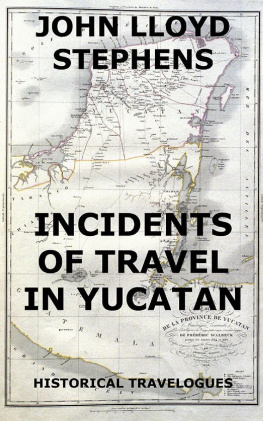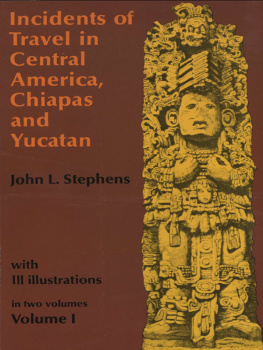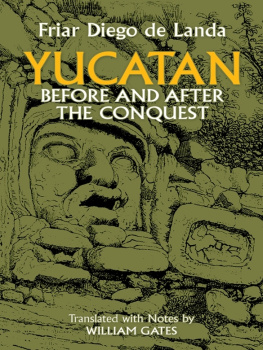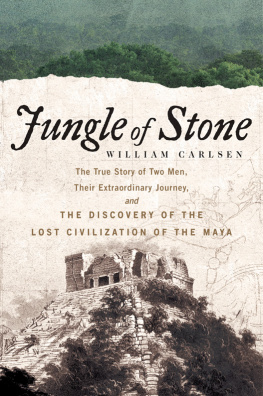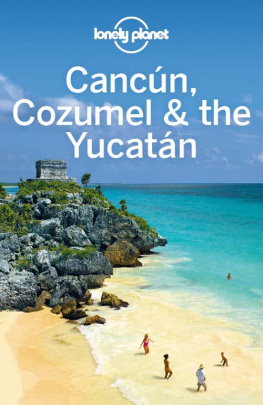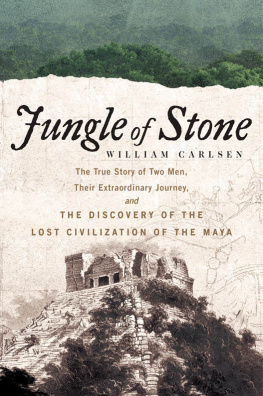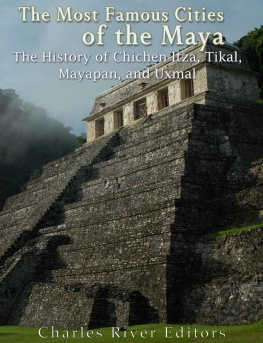Incidents Of Travel In Yucatan
John L. Stephens
Contents:
Incidents Of Travel In Yucatan, John Stephens
Jazzybee Verlag Jrgen Beck
86450 Altenmnster, Germany
ISBN: 9783849622756
www.jazzybee-verlag.de
Incidents Of Travel In Yucatan The Story Of The Book
It was hard to imagine, at the time when Mr. Stephens traveled through the region of central America, that anywhere in the world more treasures could be laid out before the discoverer than there. If you have the map nearby try to find the peninsula of Yucatn. It stretches out into the sea of Mexico with Cuba denying half way on a thought line directly to Florida. It is an ideal position, politically and commercially. In the foreground we have the West Indian Archipelago, in the South a big portion of the Western world and in the West the Pacific ocean. Central America connects two halves of the Western Hemisphere, with Yucatn sticking out of his big land mass. You will find nothing similar on the whole globe. At the time when Mr. Stephens traveled this country the main thought of everybody was: why was this not discovered earlier?
Stephens was a lucky man. Central America was not the first part of the world which he traveled extensively. He was sent there as diplomatic representative of the United States and was on his way back to the United States when he found some of the ruins of the aborigines. With every location he visited, he heard of more. With him were Mr. Catherwood, whose task it was to facilitate some drawings, and Dr. Cabot, a renowned physician and ornithologist. The region which they describe in this book is not very large. Its boundaries are two degrees of longitude and a little less than 1 of latitude. The primeval condition of the country limited them to this area. Still Mr. Stephens was able to visit more than 40 places and ruins of cities.
He found huge and extensive buildings that were built on artificial mounds as well as buildings that look like those of ancient Babylon. And he was sure that there was much more to discover when the tropical forest would give way in later times. A lot of his discoveries came to him accidentally. Sometimes the party just went through the forest and stroke a building on its way. On other occasions the talks to Indians gave them indications where to look.
This more or less accidental visit in 1838/1839 was not the only one he undertook there. Another one followed in 1841 and the researches in Yucatn were extended with every stay. The support Stephens got from the local authorities grew and many workers and helpers were put at his disposal. And the rewards came soon. He discovered places like Palenque and Copan and the high excitement behind these discoveries gave him the spirits to constantly fight on for new places.
Stephens brilliantly describes the places he found in this book. Not too many people have wandered over the world and discovered more than he did. This book gives ample proof about his attitude and the efforts he undertook to find places which nobody saw before him.
VOLUME I.
PREFACE.
In his "Incidents of Travel in Central America, Chiapas, and Yucatan," the author intimated his intention to make a more thorough exploration of the ruins of the latter country. That intention has since been carried into effect, and the following pages are the result. They describe, as the author has reason to believe, the most extensive journey ever made by a stranger in that peninsula, and contain the account of visits to forty-four ruined cities, or places in which remains or vestiges of ancient population were found. The existence of most of these ruins was entirely unknown to the residents of the capital;but few had ever been visited by white inhabitants;they were desolate, and overgrown with trees. For a brief space the stillness that reigned around them was broken, and they were again left to solitude and silence. Time and the elements are hastening them to utter destruction. In a few generations, great edifices, their faades covered with sculptured ornaments, already cracked and yawning, must fall, and become mere shapeless mounds. It has been the fortune of the author to step between them and the entire destruction to which they are destined; and it is his hope to snatch from oblivion these perishing, but still gigantic memorials of a mysterious people. The descriptions are accompanied by full illustrations from Daguerreotype views and drawings taken on the spot by Mr. Catherwood, and the engravings were executed under his personal superintendence.
CHAPTER I.
Embarcation.Fellow-passengers.A Gale at Sea.Arrival at Sisal.Ornithological Specimens.Merida.Fte of San Cristoval.The Lottery.A Scene of Confusion.Principle of the Game.Passion for Gambling.A deformed Indian.
The reader of my "Incidents of Travel in Central America, Chiapas, and Yucatan," may remember that the researches of Mr. Catherwood and myself in the last-mentioned country were abruptly terminated by the illness of the former. During our short sojourn in Yucatan, we received vague, but, at the same time, reliable intelligence of the existence of numerous and extensive cities, desolate and in ruins which induced us to believe that the country presented a greater field for antiquarian research and discoveries than any we had yet visited. Under these circumstances, it was a severe hardship that we were compelled to leave it, and our only consolation in doing so was the hope of being able to return, prepared to make a thorough exploration of this unknown and mysterious region. In about a year we found ourselves in a condition to do so; and on Monday, the ninth of October, we put to sea on board the bark Tennessee, Scholefield master, for Sisal, the port from which we had sailed on our return to the United States.
The Tennessee was a down-Easter of two hundred and sixty tons burden, turned out apparently from one of those great factories where ships are built by the mile and chopped off to order, but stout, strong, well manned and equipped.
Her cargo was assorted for the Yucatan market, and consisted of a heavy stratum of iron at the bottom; midway were miscellanies, among which were cotton, muskets, and two hundred barrels of turpentine; and on top, within reach of the hatches, were six hundred kegs of gunpowder.
We had a valuable addition to our party in Dr. Cabot, of Boston, who accompanied us as an amateur, particularly as an ornithologist. Besides him, our only fellow-passenger was Mr. Camerden, who went out as supercargo.
The first morning out we woke with an extraordinary odour of turpentine, giving us apprehensions that a barrel had sprung a leak, which, by means of the cotton, might use up our gunpowder before it came to the hands of its consignee. This odour, however, was traced to a marking-pot, which quieted our apprehensions.
On the evening of the fourth day we had a severe thunder-storm. This was an old acquaintance of ours in the tropics, but one which at that time we were not disposed to welcome very cordially. Peals of thunder broke and crashed close over our heads, lightning flashed across the dark vault of the heavens, lighting up the surface of the water, and making fearfully visible our little vessel, tossing and pitching, a mere speck in immensity; and at times an angry ray darted toward the horizon, as if expressly to ignite our gunpowder. We discussed, though rather disjointedly, the doctrine of conductors and non-conductors, and advised the captain to put a few links of a chain cable round the mainmast, and carry the end of it over the side. We had some consolation in thinking that six hundred kegs were no worse than sixty, and that six would do our business; but, in fact, at the moment, we were very much of opinion that lightning and gunpowder were the only dangers of the sea. The night, however, wore through, and morning brought with it the usual, and, unhappily, almost the only change in those who go down to the sea in shipsforgetfulness of past danger.

